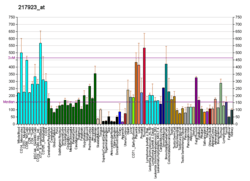Peflin
Peflin is a protein that in humans is encoded by the PEF1 gene.[5][6][7]
PEF1 is a Ca(2+)-binding protein that belongs to the penta-EF hand (PEF) protein family, which includes the calpain small subunit (CAPNS1; MIM 114170), sorcin (SRI; MIM 182520), grancalcin (GCA; MIM 607030), and ALG2 (PDCD6; MIM 601057) (Kitaura et al., 2001).[supplied by OMIM][7]
Interactions
References
- 1 2 3 GRCh38: Ensembl release 89: ENSG00000162517 - Ensembl, May 2017
- 1 2 3 GRCm38: Ensembl release 89: ENSMUSG00000028779 - Ensembl, May 2017
- ↑ "Human PubMed Reference:".
- ↑ "Mouse PubMed Reference:".
- ↑ Kitaura Y, Watanabe M, Satoh H, Kawai T, Hitomi K, Maki M (Oct 1999). "Peflin, a novel member of the five-EF-hand-protein family, is similar to the apoptosis-linked gene 2 (ALG-2) protein but possesses nonapeptide repeats in the N-terminal hydrophobic region". Biochem Biophys Res Commun. 263 (1): 68–75. doi:10.1006/bbrc.1999.1189. PMID 10486255.
- ↑ Kitaura Y, Satoh H, Takahashi H, Shibata H, Maki M (Mar 2002). "Both ALG-2 and peflin, penta-EF-hand (PEF) proteins, are stabilized by dimerization through their fifth EF-hand regions". Arch Biochem Biophys. 399 (1): 12–8. doi:10.1006/abbi.2001.2736. PMID 11883899.
- 1 2 "Entrez Gene: PEF1 penta-EF-hand domain containing 1".
- ↑ Kitaura, Y; Matsumoto S; Satoh H; Hitomi K; Maki M (Apr 2001). "Peflin and ALG-2, members of the penta-EF-hand protein family, form a heterodimer that dissociates in a Ca2+-dependent manner". J. Biol. Chem. United States. 276 (17): 14053–8. doi:10.1074/jbc.M008649200. ISSN 0021-9258. PMID 11278427.
Further reading
- Kitaura Y, Matsumoto S, Satoh H, et al. (2001). "Peflin and ALG-2, members of the penta-EF-hand protein family, form a heterodimer that dissociates in a Ca2+-dependent manner". J. Biol. Chem. 276 (17): 14053–8. doi:10.1074/jbc.M008649200. PMID 11278427.
- Satoh H, Nakano Y, Shibata H, Maki M (2002). "The penta-EF-hand domain of ALG-2 interacts with amino-terminal domains of both annexin VII and annexin XI in a Ca2+-dependent manner". Biochim. Biophys. Acta. 1600 (1–2): 61–7. doi:10.1016/S1570-9639(02)00445-4. PMID 12445460.
- Strausberg RL, Feingold EA, Grouse LH, et al. (2003). "Generation and initial analysis of more than 15,000 full-length human and mouse cDNA sequences". Proc. Natl. Acad. Sci. U.S.A. 99 (26): 16899–903. Bibcode:2002PNAS...9916899M. doi:10.1073/pnas.242603899. PMC 139241. PMID 12477932.
- Hansen C, Tarabykina S, la Cour JM, et al. (2003). "The PEF family proteins sorcin and grancalcin interact in vivo and in vitro". FEBS Lett. 545 (2–3): 151–4. doi:10.1016/S0014-5793(03)00518-0. PMID 12804766.
- Clark HF, Gurney AL, Abaya E, et al. (2003). "The secreted protein discovery initiative (SPDI), a large-scale effort to identify novel human secreted and transmembrane proteins: a bioinformatics assessment". Genome Res. 13 (10): 2265–70. doi:10.1101/gr.1293003. PMC 403697. PMID 12975309.
- Ota T, Suzuki Y, Nishikawa T, et al. (2004). "Complete sequencing and characterization of 21,243 full-length human cDNAs". Nat. Genet. 36 (1): 40–5. doi:10.1038/ng1285. PMID 14702039.
- Rual JF, Venkatesan K, Hao T, et al. (2005). "Towards a proteome-scale map of the human protein-protein interaction network". Nature. 437 (7062): 1173–8. Bibcode:2005Natur.437.1173R. doi:10.1038/nature04209. PMID 16189514.
- Jordanova A, Irobi J, Thomas FP, et al. (2006). "Disrupted function and axonal distribution of mutant tyrosyl-tRNA synthetase in dominant intermediate Charcot-Marie-Tooth neuropathy". Nat. Genet. 38 (2): 197–202. doi:10.1038/ng1727. PMID 16429158.
This article is issued from
Wikipedia.
The text is licensed under Creative Commons - Attribution - Sharealike.
Additional terms may apply for the media files.




